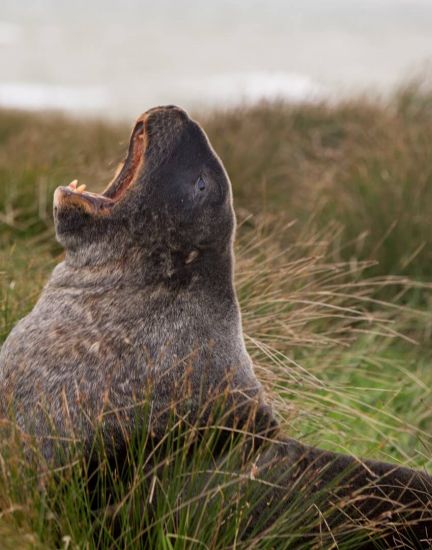
The Sea
The numerous species of coastal and marine wildlife is a major feature of the Catlins coast. The sea is particularly rich because the mixing of warm and cool waters immediately off the coast produces an up-welling of nutrients.
Inshore, the north-flowing Southland current is of warm, sub-tropical origin, while some 20-40 kilometres offshore this current converges with cool, sub-Antarctic surface water.
Wildlife
The nutrient-rich waters support the marine mammal population of fur seals, New Zealand sea lions, Hector’s dolphins and whales as well as far-ranging birds such as albatross, gannets and millions of petrels. Particularly notable amongst the latter are the Titi (Sooty Shearwaters).
Breeding populations of Yellow-eyed penguin and little Blue Penguin are found all along the coast where the giant kelp (Rimurapa) protects the land (Papatuanuku) and the forests (Tane) from the violence of the sea (Tangaroa), and the inshore fish and invertebrates thrive in a rich, pollution-free environment.
The Catlins has some of the last remaining natural coast-to-hilltop catchments on the east coast of New Zealand. These rivers contain introduced trout and native invertebrates and still have good numbers of native fish such as Inanga and Kokupu, the fish that form the main whitebait fishery catch.
The jewels in the crown of The Catlins’ marine life are three species which are the rarest of their kind; namely the Hector’s dolphin, the New Zealand sea lion and the Yellow-eyed penguin (hoiho).
Hector's dolphin
The Hector’s dolphin (Cephalorhyncus Hectori) is the world’s rarest and smallest species of dolphin (it was named after Sir James Hector, a prominent New Zealand scientist of the mid to late 1800s). It is found only off the coast of New Zealand and is light grey in colour with distinctive black and white markings. Its most notable feature is its rounded dorsal fin – other dolphin species have more crescent-shaped or pointed fins.
Hector’s dolphins grow to about 1.2 metres-1.4 metres compared to 4 metres for a bottlenose dolphin. They feed on fish and sea creatures such as red cod, mackerel, flounder, squid and crabs and they use echo-location to find their prey. Hector’s dolphins were given “threatened species” status in 1999 as there are only 3,000-4,000 of them left around the New Zealand coast. The females are not prolific producers as they have one calf only every 2 or 3 years. Hector’s dolphins live to about 15- 18 years of age.
A group of Hector’s dolphins have made their home in the Curio and Porpoise Bay areas of the southern Catlins. Porpoise Bay is a popular and safe swimming and surfing beach just 2 km. south of the Waikawa Information Centre and Museum.
You may be fortunate enough to see Hector’s dolphins just beyond the breaker line in the bay. During summer, they come in quite close to the shore. In wintertime they tend to disappear from the bay. The dolphins are shy creatures and easily frightened.
If swimming or surfing, please do not approach them. However, they may swim over to investigate people swimming, surfing or boating as they are very inquisitive creatures. It is a rare privilege to view the Hector’s dolphins in their natural habitat.
Please respect these wonderful creatures of the southern oceans.
New Zealand Sea lions (Rapoka/Whakahao) and Fur Seals (Kakaeno)
The world’s rarest sea lion live and breed in The Catlins as well as large populations of the New Zealand (NZ) fur seal and the occasional elephant seal. The New Zealand sea lions (formerly called Hooker’s sea lions), can be seen at Waipapa Point, Surat Bay and Cannibal Bay.
Most New Zealand sea lions live and breed in the sub-Antarctic Auckland and Campbell Islands where they number about 12,000, the fewer than 200 on the mainland are all found on the south east coast. These sea lions are the world’s rarest sea lion species and are of great interest, especially as they have recently started breeding on this coast.
Sea lions are confident and intelligent animals who show little fear of humans. Although they are not usually dangerous, they can be aggressive and should be treated with respect. A mature bull sea lion can weigh up to 500kg!
Fur seals (Kekeno) are often seen in significant numbers around the coast on rocky shores. They are shyer of humans than of sea lions and can be dangerous if cornered so give them plenty of space. Fur seals are also shy of the sea lions which have been known to eat their pups on occasions. A rare visitor to The Catlins’ shores is the elephant seal, a 4-tonne giant of the sub -Antarctic.
For more information on seals visit www.doc.govt.nz
You can take a look at the Where to See page for more information.